
Electric Lab Press
Laboratory Hydraulic Press Lab Pellet Press for Button Battery
Item Number : PCBP
Price varies based on specs and customizations
- Working pressure
- 0-2 T
- Sealing pressure
- 08-1.2 T
Shipping:
Contact us to get shipping details Enjoy On-time Dispatch Guarantee.
Why Choose Us
Reliable PartnerEasy ordering process, quality products, and dedicated support for your business success.
Applications
Hydraulic press is widely used in material researching labs,pharmacy,catalytic reaction,ceramics, electronic industries, it is one high efficient equipment for the sample preparing, due to its small footprint, it easy to carry and move, can work inside the vacuum glove box for processing under vacuum environment. Hydraulic press can also process hot press function with heating plates, which can serve the particular material processing
Feature
- Small footprint, light weight, easy to carry and move, nice fitting vacuum glove box
- Pressure gauge with double pressure indicator, save pressure converting time
- Ideal for battery researching labs or small scale production
Detail & Parts



- Size: The equipment is small in size, light in weight, does not leak oil, and is easy to transport and can be placed in the glove box for use.
- Structure: One-piece mainboard structure, oil pool, mainboard, and oil cylinder are on one main body, without sealed connections to reduce oil leakage.
- Accuracy: You can choose a digital pressure gauge, which has high pressure control accuracy and good battery sealing effect.
Advantages
- The upper plate adopts electroplated countersunk head hexagonal screws, beautiful and space-saving
- Chrome-plated cylinder, smooth surface, no rust, good sealing rubber ring, no oil leakage
- One-piece main board structure, oil pool, main board, oil cylinder in a body, no seal connection
- Extended pulling spring, good rebound effect, not easy to deformation, can achieve the cylinder 30mm return without deformation
- All aluminum alloy hand wheel, beautiful, practical, not easy to break
- Small size, light weight, no oil leakage, can be used in the glove box
- Mold using Japanese high-speed steel, good material, high hardness, no deformation, long service life
- Digital display pressure gauge, more accurate pressure control, pressure display accuracy of 0.01MPa
- Oil pool outside the host, easy to replace the oil, and the oil circuit increased the hydraulic oil filtration device
- Special plunger, using special custom sealing structure, excellent sealing effect
- Pressurizing device, placed in the lowermost corner of the mainframe, the angle is reasonable, pressurizing force does not tilt back
Technical specifications
| Instrument model | PCBP-2T (Manual) | Instrument model | PCBP-1.5T(Automatic) |
|---|---|---|---|
| Pressure range | 0-2T (0-25MPa) | Pressure Range | 50-1500kg |
| Piston diameter | Φ32mm (d) | Pressurization process | Program pressurization-program pressure-timed pressure relief |
| Integral structure | No sealing connection, oil leakage reduced | Pressure retention time | 0-999 seconds |
| Pressure gauge | Pressure and pressure intensity display | Pressure conversion | The program automatically converts the mold to withstand pressure |
| Standard die | CR20 series packaging die | LCD display | 4.3-inch LCD screen |
| Sealing die | CR16,CR20,CR24,CR30optional | Sealing mold | Optional CR16,CR20,CR24,CR30,etc |
| Sealing pressure | 0.8-1.2Ton | Shell removal mold | Optional CR16,CR20,CR24,CR30,etc |
| Disassembly die | CR16,CR20,CR24 optional | Standard mold | Standard CR20 series packaging mold |
| Disassembly pressure | External dimensions | 220x240x380(LXWXH) | |
| Dimensions | 210×165×290mm(L×W×H) | Equipment power supply | 220V(50Hz/60Hz) |
| Weight | 12Kg | Equipment weight | 35kg |
| Dimensional diagram |

|

|
|
Operating steps
How to replace accessories and precautions
The operation of Lab Manual Isostatic Press is as follows:

Step 1: Power on the automatic sealer.

Step 2: Press the Settings button to enter the settings menu.

Step 3: Adjust the maximum pressure and packing time, etc.

Step 4: Place the coin cell battery case into the mold.

Step 5: Press the Start button to start the sealing process.
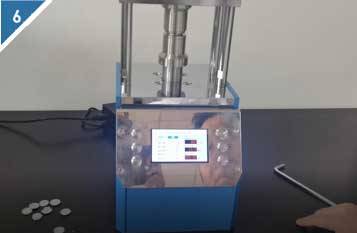
Step 6: Place the coin cell battery case into the mold.

Step 7: The device completes the sealing and relieves the pressure by itself.

Step 8: Remove the sealed battery case.
Full range of lab press types
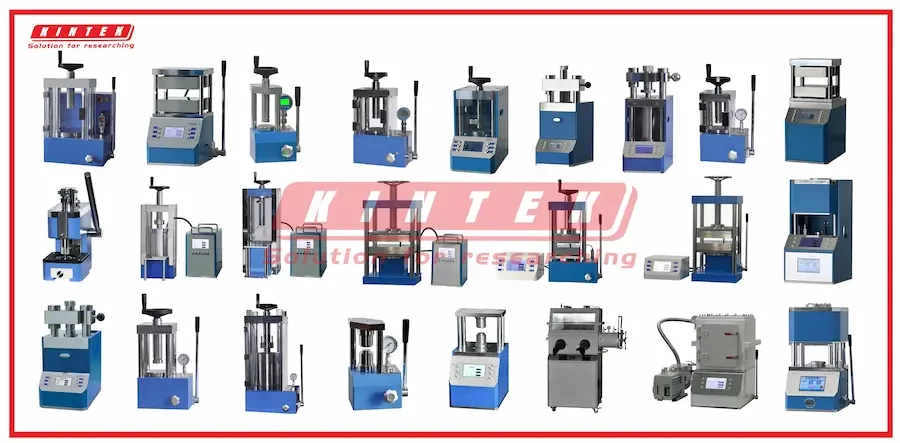
Click to view our full range of lab press products.
Any question? Our experts have helped many laboratories choose their lab press, contact us now!
Full range of types of laboratory press molds
We have a full range of molds for you to choose from, and the molds fit the body perfectly.
If you need molds with special shapes, we can also customize them for you.
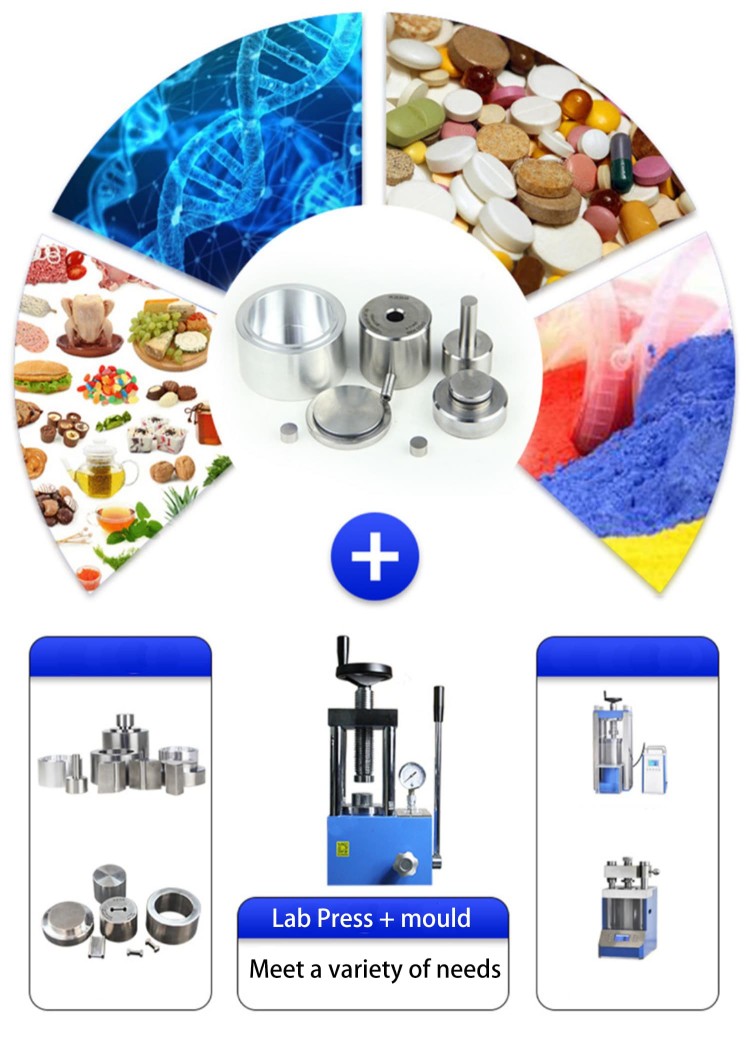
Warnings
Operator safety is the top important issue! Please operate the equipment with cautions. Working with inflammable& explosive or toxic gases is very dangerous, operators must take all necessary precautions before starting the equipment. Working with positive pressure inside the reactors or chambers is dangerous, operator must fellow the safety procedures strictly. Extra caution must also be taken when operating with air-reactive materials, especially under vacuum. A leak can draw air into the apparatus and cause a violent reaction to occur.
Designed for You
KinTek provide deep custom made service and equipment to worldwide customers, our specialized teamwork and rich experienced engineers are capable to undertake the custom tailoring hardware and software equipment requirements, and help our customer to build up the exclusive and personalized equipment and solution!
Would you please drop your ideas to us, our engineers are ready for you now!
FAQ
What Considerations Should Be Made For Battery Case Gaskets?
What Are The Applications Of Pellet Presses?
What Is The Role Of Battery Case Gaskets?
How Does A Pellet Press Work?
What Are Lithium-air Battery Cases?
What Are The Benefits Of Using A Pellet Press?
How Should Button Battery Cases Be Chosen For Specific Applications?
What Factors Should Be Considered When Selecting A Pellet Press?
4.7
out of
5
The delivery was exceptionally fast, and the quality of the product is top-notch. Highly recommended!
4.8
out of
5
Incredible value for money. This product is a must-have for any laboratory.
4.9
out of
5
The product is durable and well-made. It has exceeded my expectations.
4.6
out of
5
The technological advancements in this product are impressive. It's a game-changer for our laboratory.
4.7
out of
5
This product is a testament to the company's commitment to innovation. I highly recommend it.
4.8
out of
5
The product is user-friendly and easy to operate, making it suitable for laboratories of all levels.
4.9
out of
5
The product is versatile and can be used for various applications. It's an excellent investment for any laboratory.
4.6
out of
5
The product's safety features provide peace of mind and ensure a secure working environment.
4.7
out of
5
The product's small footprint and lightweight design make it easy to integrate into any laboratory setup.
4.8
out of
5
The product's ease of maintenance ensures long-lasting performance and minimal downtime.
4.9
out of
5
The product's wide range of applications makes it suitable for various industries and research areas.
4.6
out of
5
The product's accuracy and precision ensure reliable and consistent results.
4.7
out of
5
The product's sleek design and modern aesthetics complement any laboratory environment.
REQUEST A QUOTE
Our professional team will reply to you within one business day. Please feel free to contact us!
Related Products

Laboratory Manual Hydraulic Pellet Press for Lab Use
Efficient sample preparation with small footprint Manual Lab Hydraulic Press. Ideal for material researching labs, pharmacy, catalytic reaction, and ceramics.
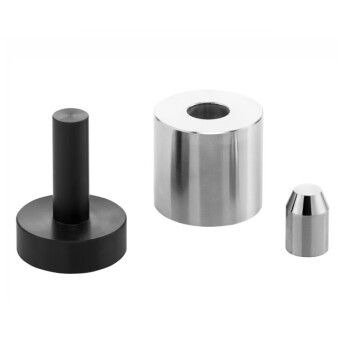
Button Battery Tablet Press Sealing Mold for Lab Use
The sealing die is essential for assembling button batteries, ensuring components like the anode, cathode, and electrolyte are securely enclosed.

Introducing the KINTEK KBR Press - a handheld laboratory hydraulic press designed for entry-level users.

Laboratory Hydraulic Pellet Press for XRF KBR FTIR Lab Applications
Efficiently prepare samples with the Electric Hydraulic Press. Compact and portable, it's perfect for labs and can work in a vacuum environment.

Laboratory Manual Hydraulic Pellet Press for Lab Use
Efficient Manure Lab Hydraulic Press with Safety Cover for sample preparation in material research, pharmacy, and electronic industries. Available in 15T to 60T.

Automatic Heated Hydraulic Press Machine with Heated Plates for Laboratory Hot Press 25T 30T 50T
Efficiently prepare your samples with our Automatic Heated Lab Press. With a pressure range up to 50T and precise control, it's perfect for various industries.

Laboratory Hydraulic Press Split Electric Lab Pellet Press
Efficiently prepare samples with a split electric lab press - available in various sizes and ideal for material research, pharmacy, and ceramics. Enjoy greater versatility and higher pressure with this portable and programmable option.

Laboratory Hydraulic Press Lab Pellet Press Machine for Glove Box
Controlled environment lab press machine for glove box. Specialized equipment for material pressing and shaping with high precision digital pressure gauge.

Automatic Heated Hydraulic Press Machine with Heated Plates for Laboratory Hot Press
The Automatic High Temperature Heat Press is a sophisticated hydraulic hot press designed for efficient temperature control and product quality processing.

Button Battery Case Gasket for Battery Lab Applications
The gasket prevents the deformation of the internal material, and the spring sheet is conducive to the tight contact inside the battery to prevent loosening.

Manual Heated Hydraulic Press Machine with Heated Plates for Laboratory Hot Press
The Manual Heat Press is a versatile piece of equipment suitable for a variety of applications, operated by a manual hydraulic system that applies controlled pressure and heat to the material placed on the piston.

Cylindrical Lab Electric Heating Press Mold for Laboratory Applications
Efficiently prepare samples with Cylindrical Lab Electric Heating Press Mold. Fast heating, high temp & easy operation. Custom sizes available. Perfect for battery, ceramic & biochemical research.

Button Battery Case for Battery Lab Applications
Button batteries are also known as micro batteries. It looks like a small button-shaped battery. Usually larger in diameter and thinner in thickness.
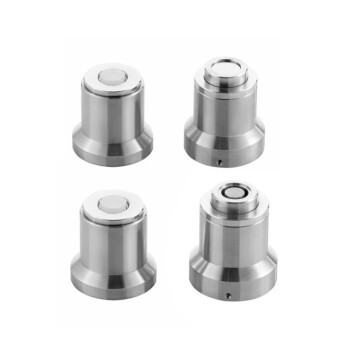
Button Battery Disassembly and Sealing Mold for Lab Use
The simple sealing and disassembly mold can be directly used on ordinary tablet presses, which can save costs, is convenient and fast, and can be used to encapsulate and disassemble button batteries. Other specifications can be customized.

Heated Hydraulic Press Machine with Heated Plates Split Manual Laboratory Hot Press
Efficiently prepare your samples with our Split Manual Heated Lab Press. With a pressure range up to 40T and heating plates up to 300°C, it's perfect for various industries.

Assemble Square Lab Press Mold for Laboratory Applications
Achieve perfect sample preparation with Assemble Square Lab Press Mold. Quick disassembly eliminates sample deformation. Perfect for battery, cement, ceramics, and more. Customizable sizes available.

Explore versatile Hydraulic Hot Press molds for precise compression molding. Ideal for creating various shapes and sizes with uniform stability.

Platinum Sheet Electrode for Battery Lab Applications
Platinum sheet is composed of platinum, which is also one of the refractory metals. It is soft and can be forged, rolled and drawn into rod, wire, plate, tube and wire.

Button Battery Storage Box for Battery Lab
Button-type battery storage box, detachable, high-quality PP environmental protection material; suitable for small objects/chemicals, etc., thickened, compressive, durable, and available in a variety of styles.
Related Articles

Automatic Hydraulic Press: The Ultimate Guide for Efficient Sample Preparation and Industrial Processes
Discover the world of automatic hydraulic presses, from their versatile applications in industrial XRF and laboratory sample manipulation to their role in large-scale manufacturing, hot embossing, laminating, and polymer melting. Learn about their benefits, features, and how they revolutionize sample preparation and industrial processes.

Comprehensive Guide to Hydraulic Hot Press: Function, Features and Applications
Hydraulic hot press is equipped with advanced electronic controls that allow for precise temperature selection and technical control. This enables the machine to automatically carry out processes such as stage temperature adjustment and film pressure control.

The Science Behind Hydraulic Presses and Their Applications
Hydraulic presses are machines that use hydraulic pressure to compress, mold, or shape a material. The basic concept of hydraulic presses is Pascal’s principle, which states that a pressure applied to an enclosed fluid is transmitted uniformly in all directions.

Operating steps and precautions for electric tablet press
Relevant introduction to the operating steps and precautions of electric tablet press.

An Insight into Hydraulic Presses: Versatility, Efficiency, and Industrial Applications
Hydraulic presses have become an integral part of various industries due to their versatility and efficiency. These powerful machines utilize hydraulic systems to generate force, allowing them to perform a wide range of industrial applications effectively. From metalworking and plastics processing to woodworking, hydraulic presses play a crucial role in numerous industrial processes.

Manual mechanical press operating steps
Introduction to the operating steps of manual mechanical press.

How to Ensure Workplace Safety When Using a Hydraulic Press in Your Lab
Hydraulic presses are essential tools in many laboratories, used for a range of applications such as sample preparation for chemical analysis, material testing, and pressing powders.

Applications and Importance of Hydraulic Press in Laboratories
A hydraulic press is a machine that uses the pressure generated in a confined fluid to configure metals, plastics, rubber, and other materials. Its operation is governed by Pascal’s principle, which states that pressure applied to a confined fluid is transmitted unaltered throughout the fluid.

Why Your Lab Pellets Crack: The Hidden Physics of a Perfect Press
Stop blaming your powder. Discover the real reason your lab pellets fail and how a precision hydraulic press solves inconsistent sample prep for good.

Detailed Analysis of Tablet Presses: Their Types, Components, and Applications
Tablet presses are machines designed to compress pharmaceutical powders and granules into tablets. They play a crucial role in the pharmaceutical industry by ensuring the uniformity of each dosage unit, which is essential for patient safety. The precision capabilities offered by modern tablet presses are invaluable for pharmaceutical companies, as they help create tablets that contain the same amount of active pharmaceutical ingredients and excipients.

Battery sealing machine operating steps and precautions
Introduction to the operating steps and precautions of the battery sealing machine

Understanding Hydraulic Pellet Press: Working Mechanism and Applications
A hydraulic press, also known as a Bramah press, is a machine that uses fluid pressure to generate a force. This force can be used to compress or mold materials. Hydraulic presses are commonly used in manufacturing and industrial applications due to their ability to exert a large amount of force while still being easy to operate.